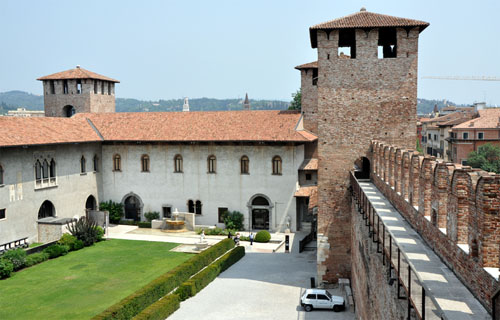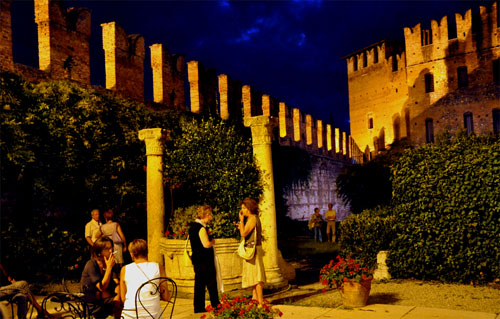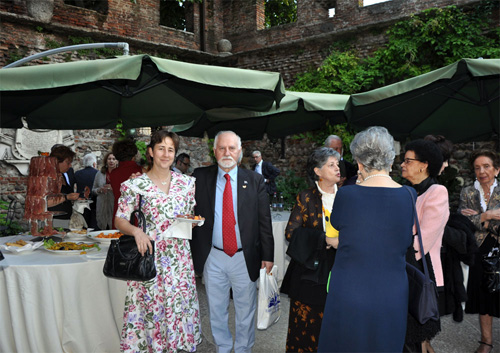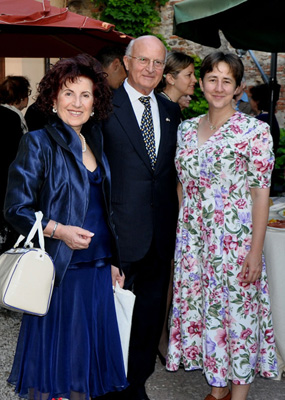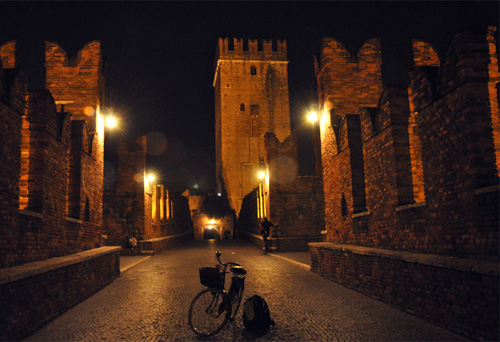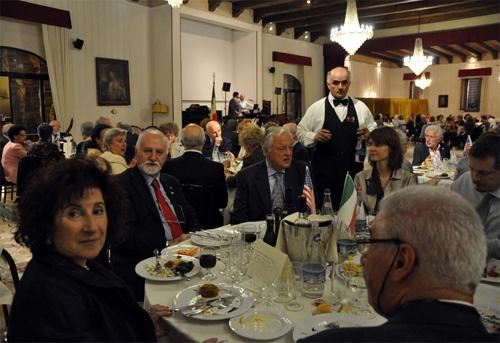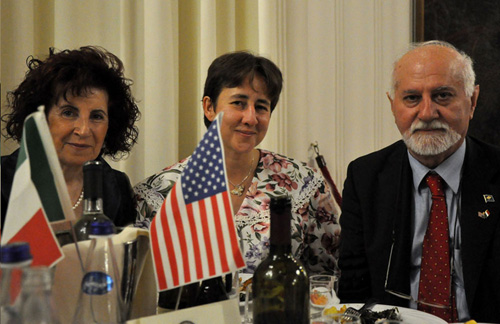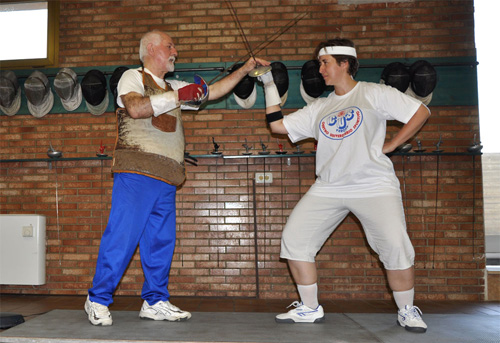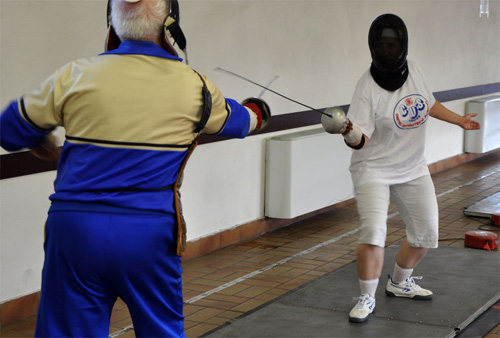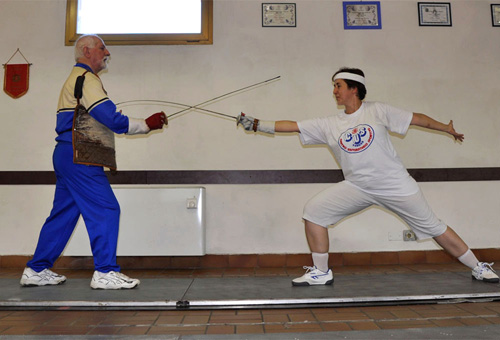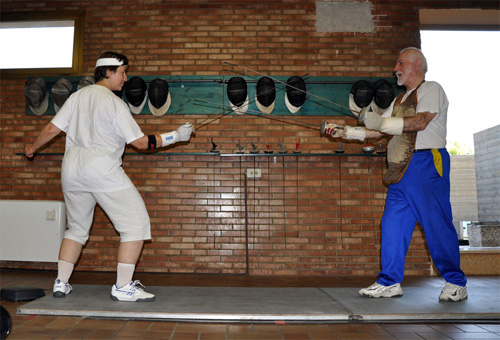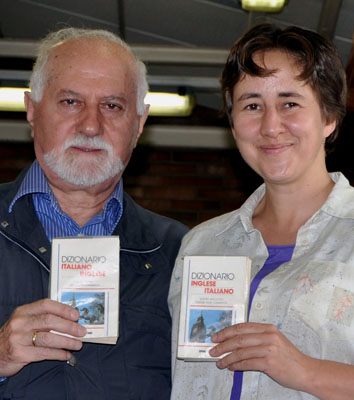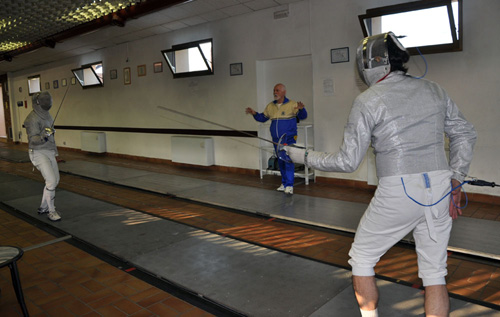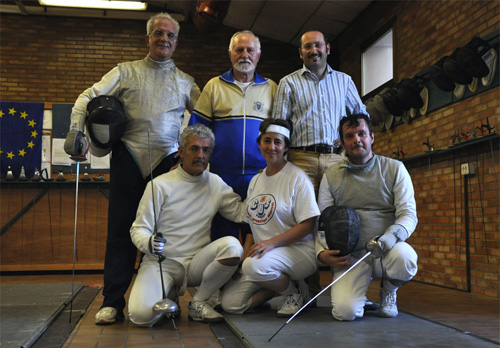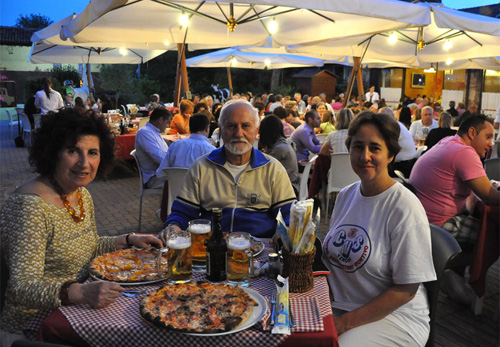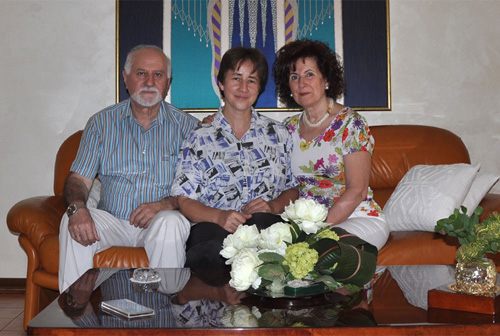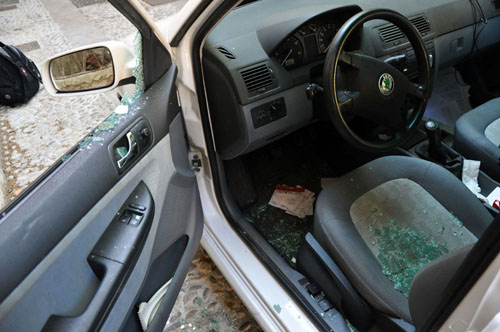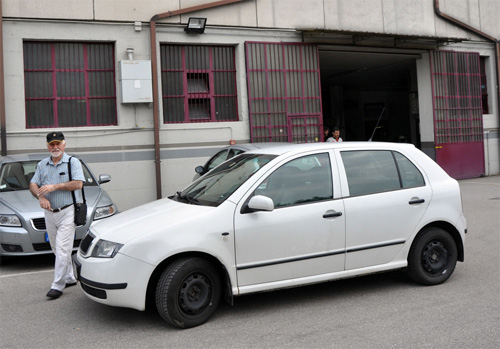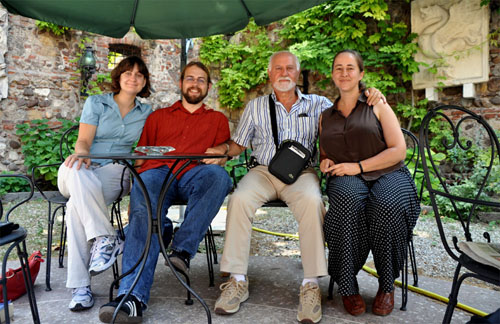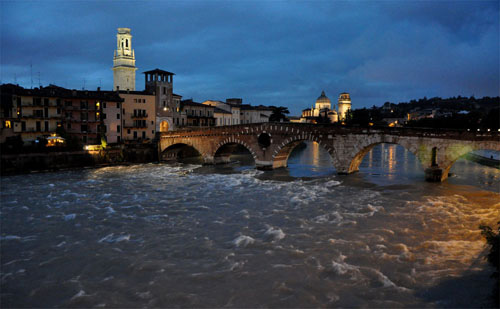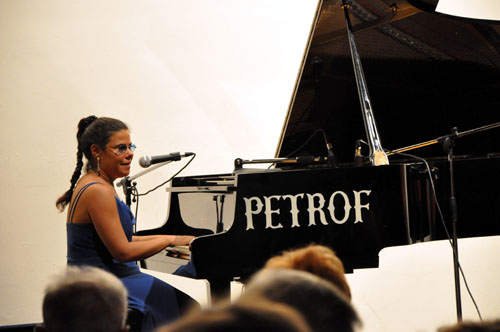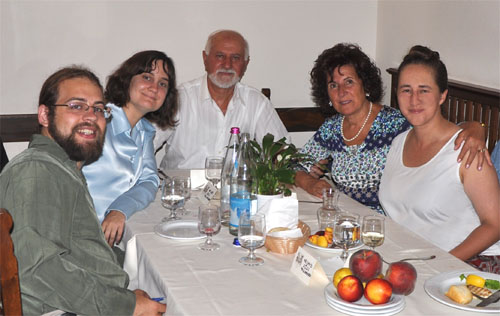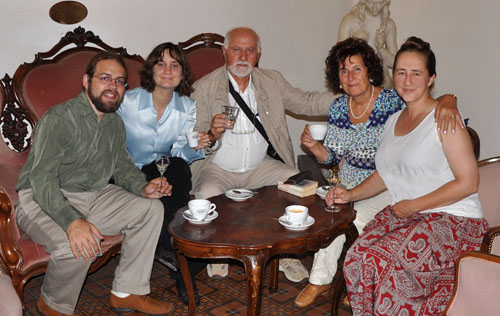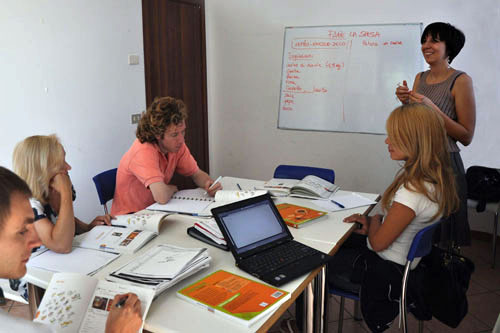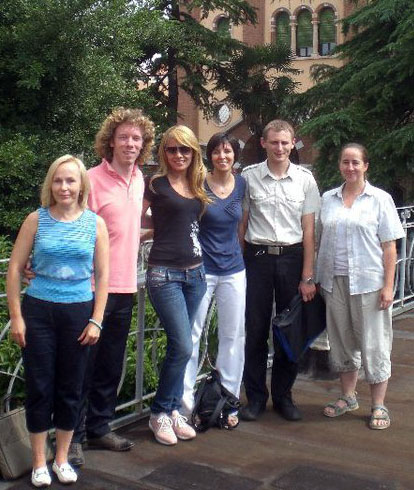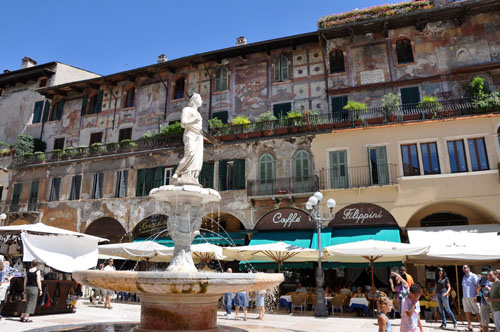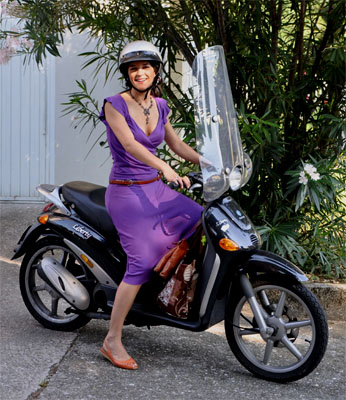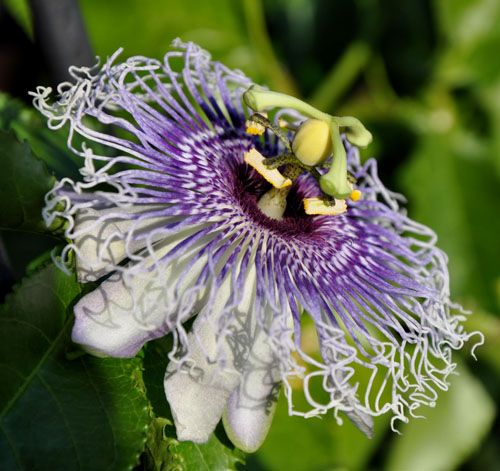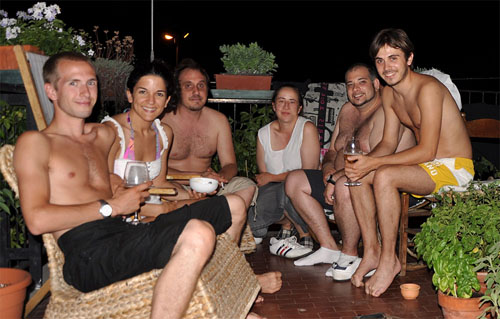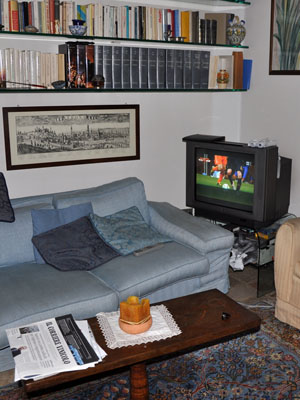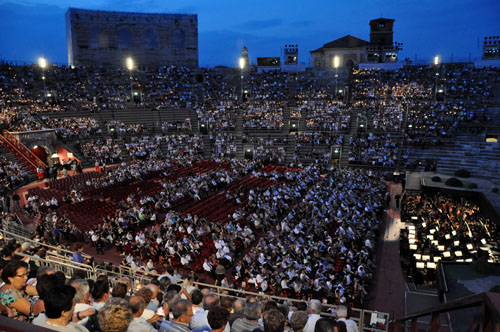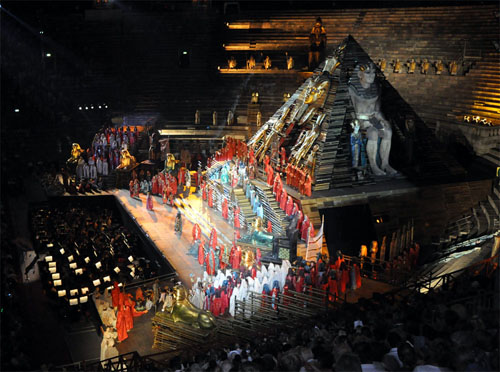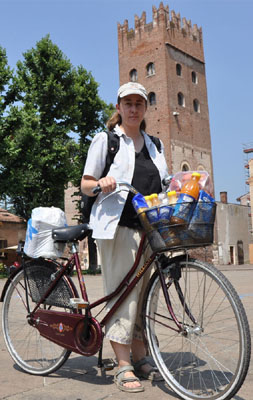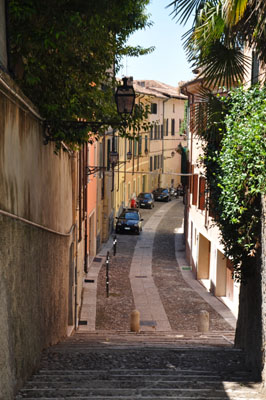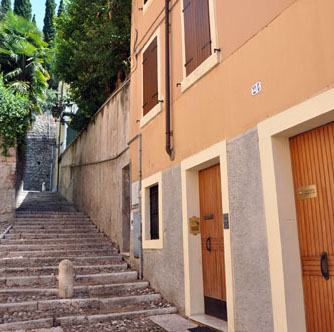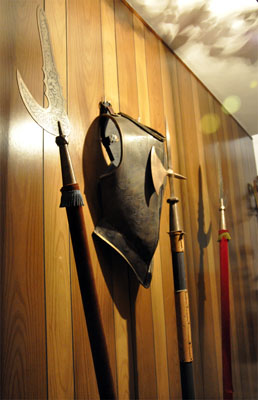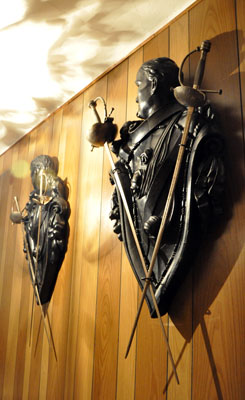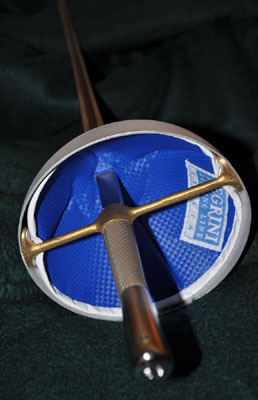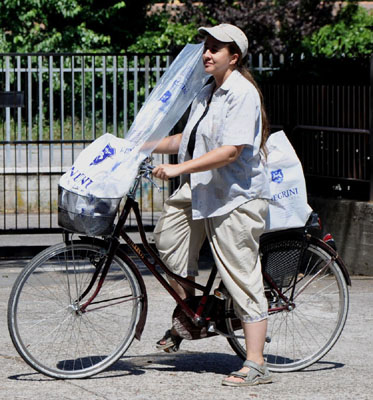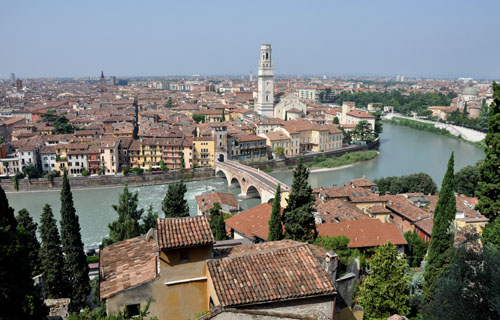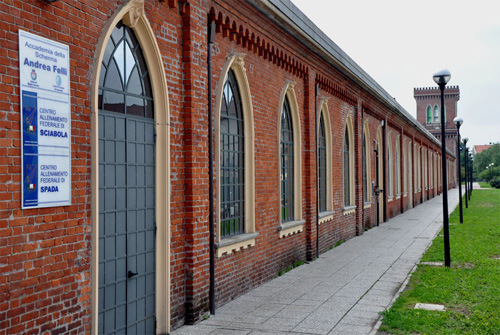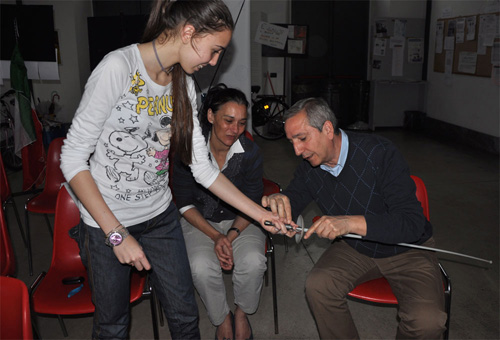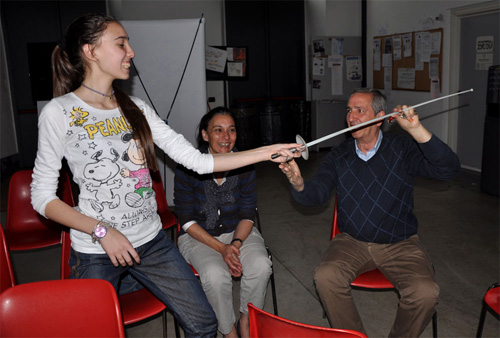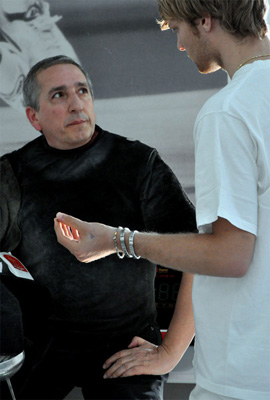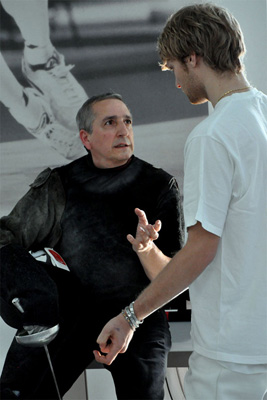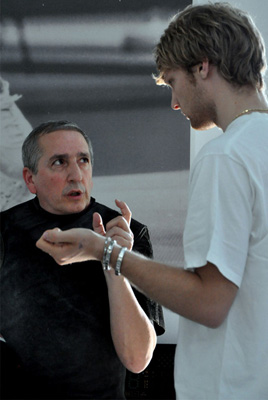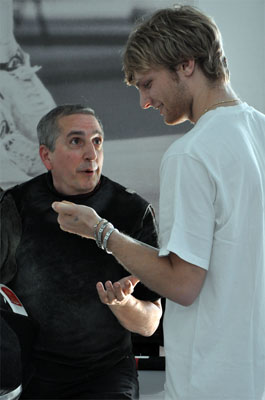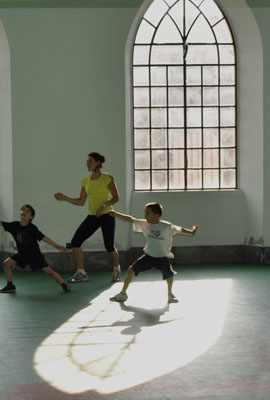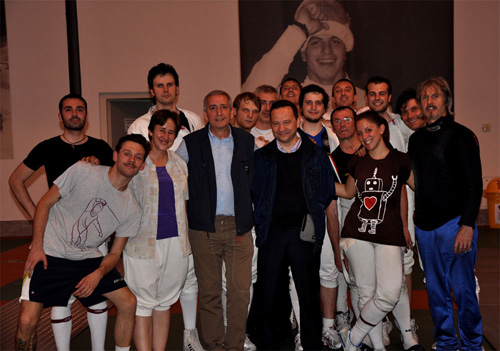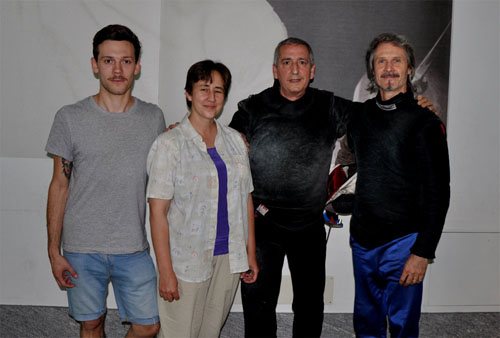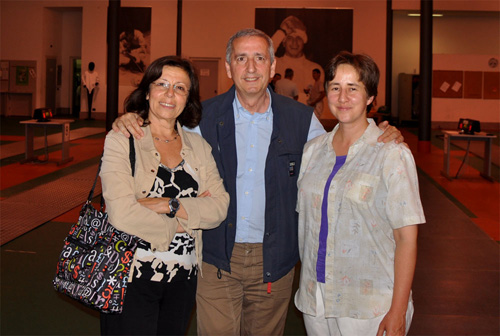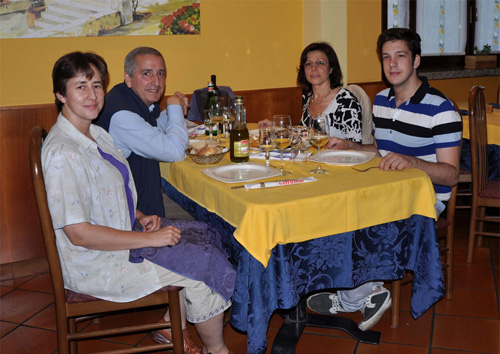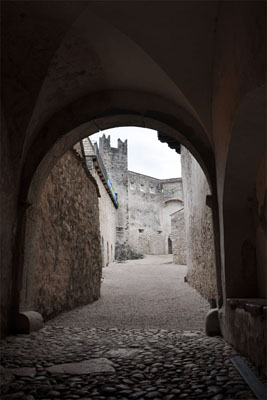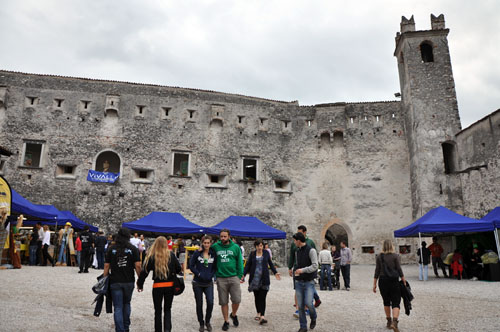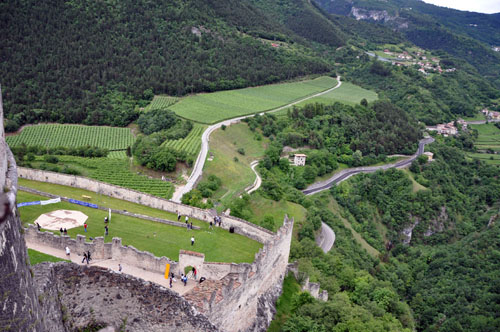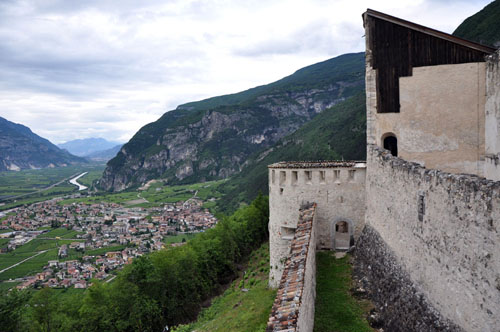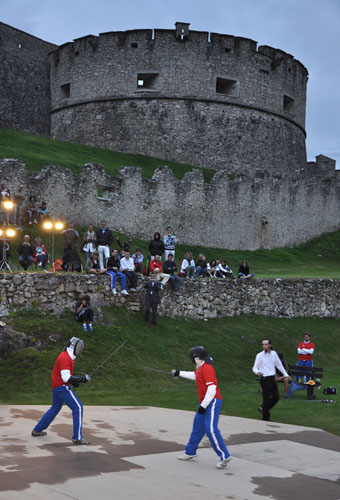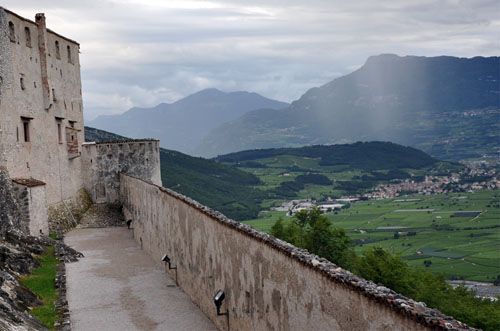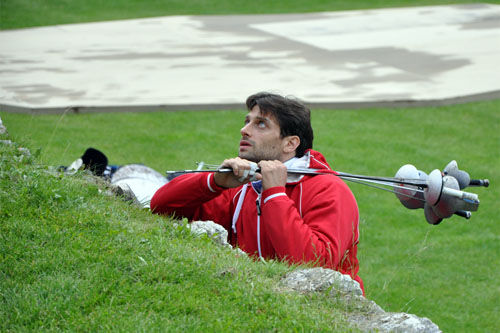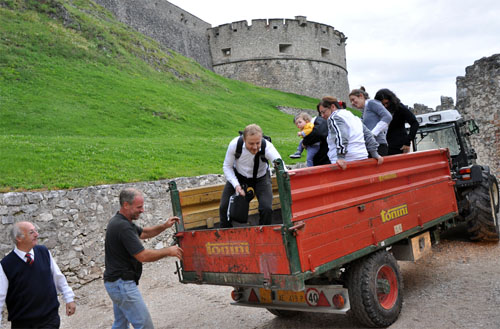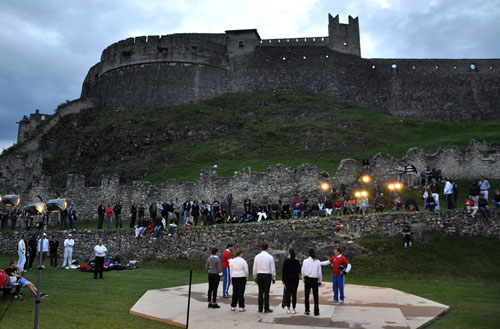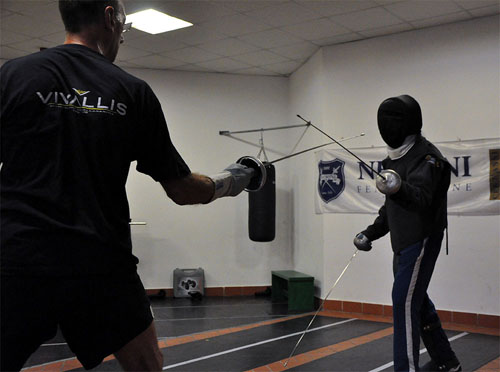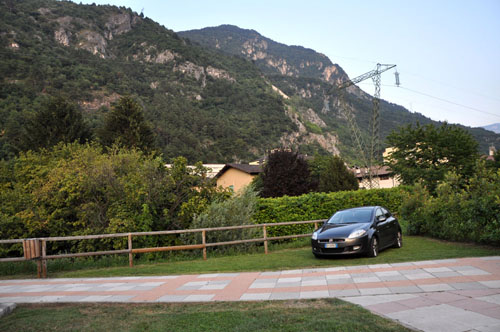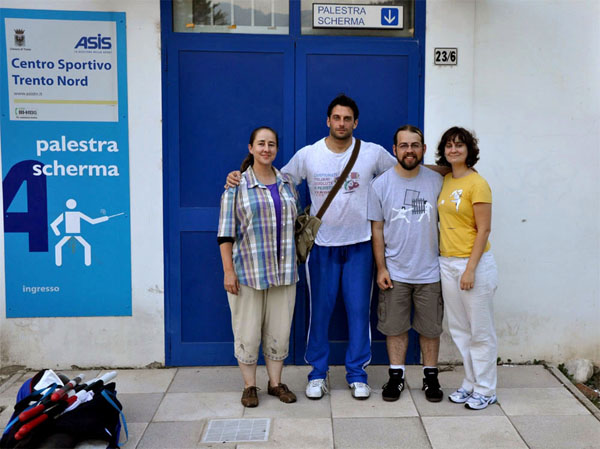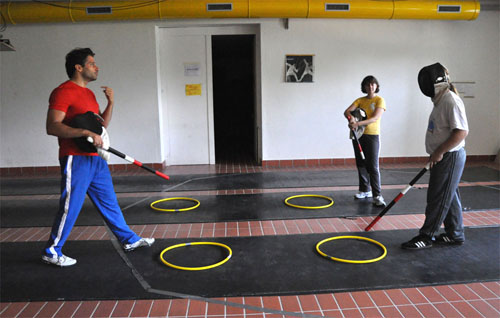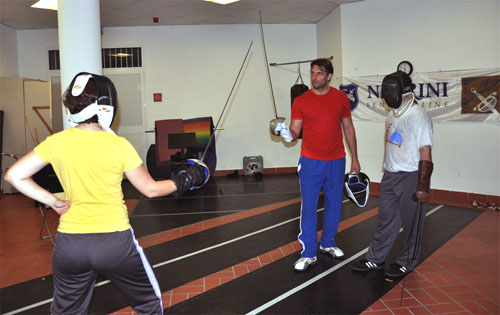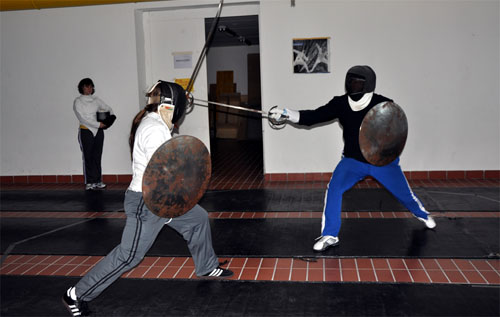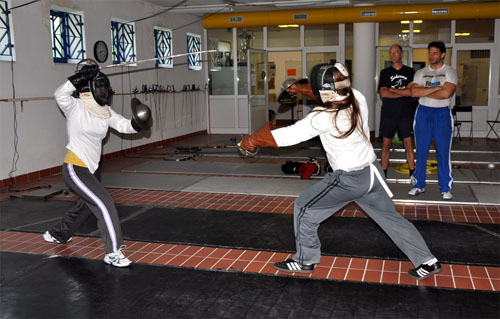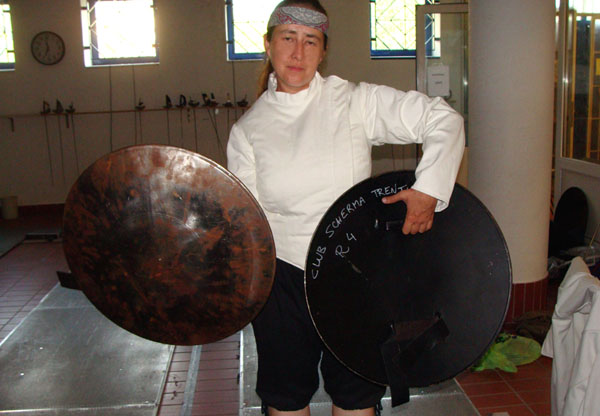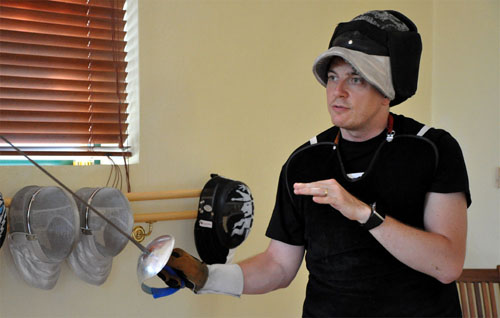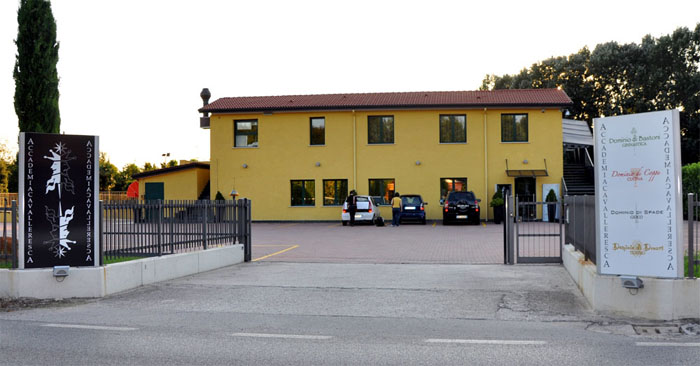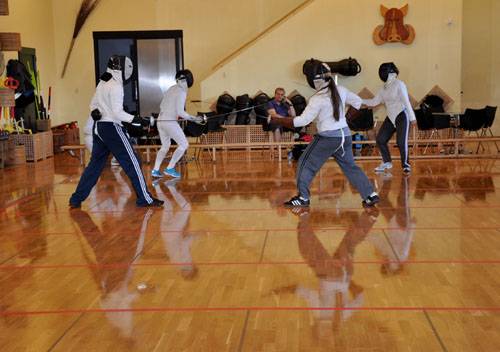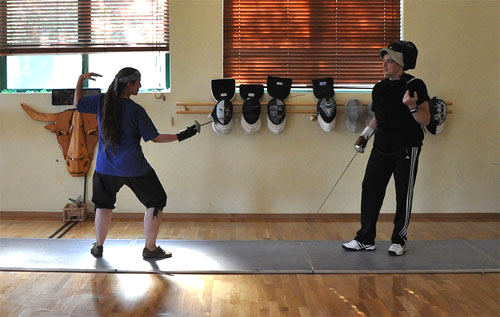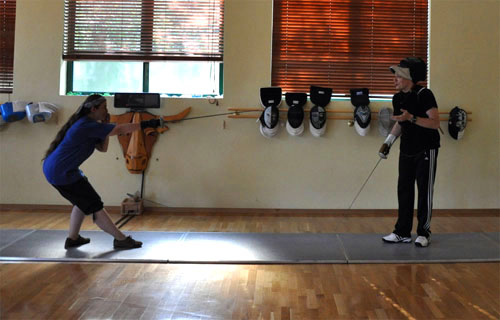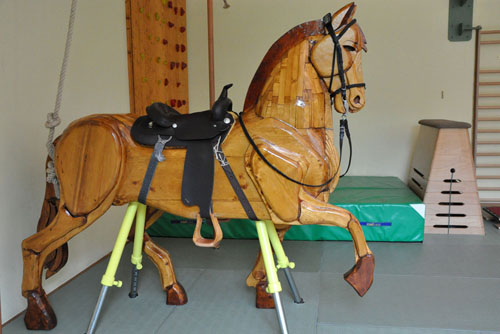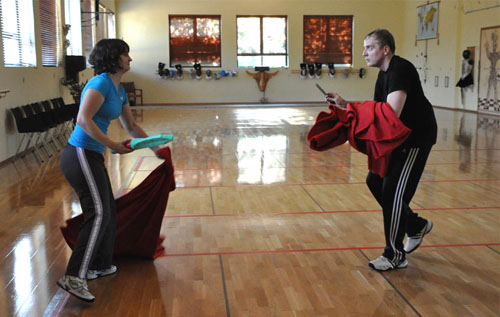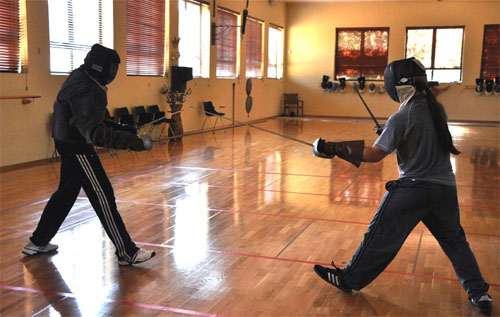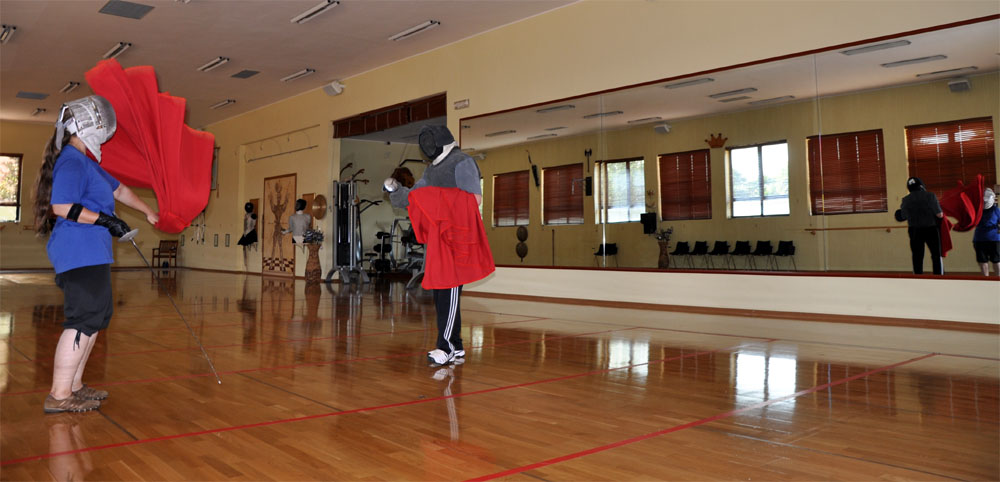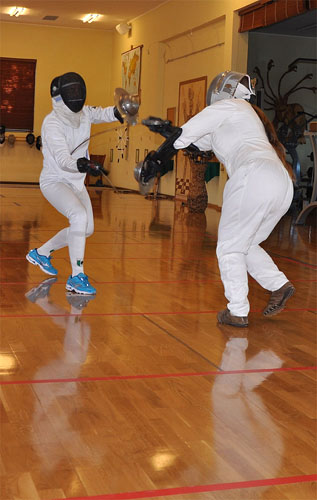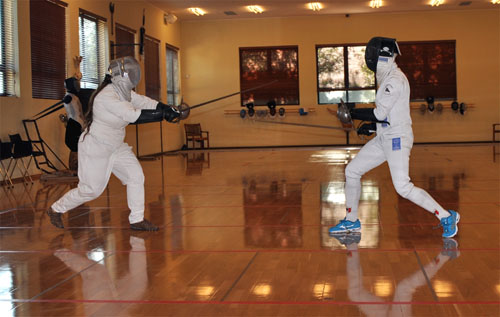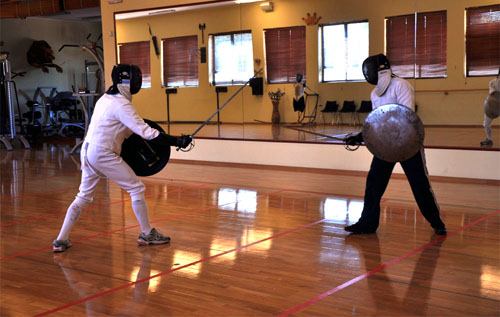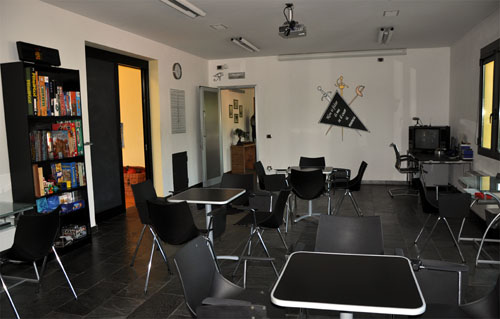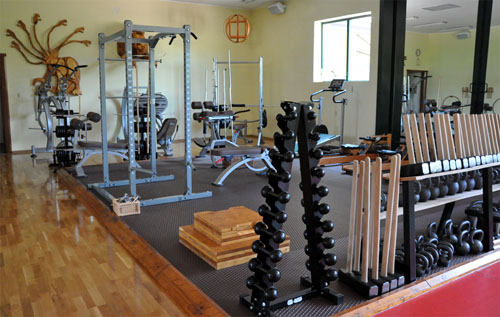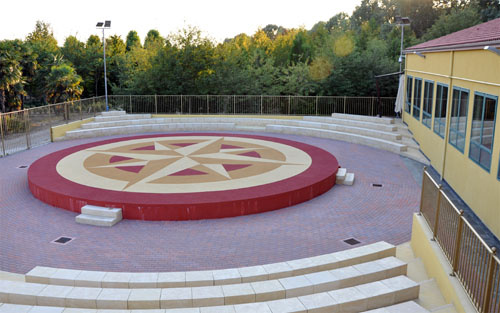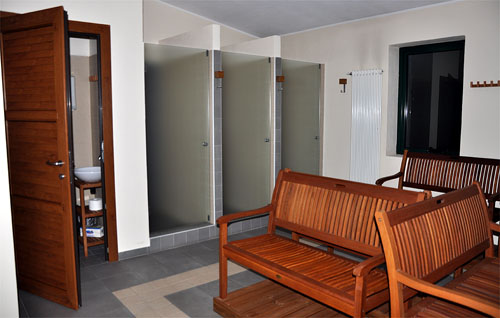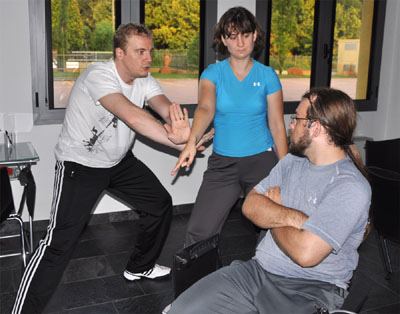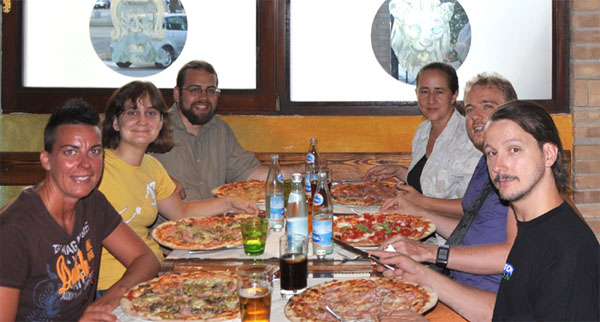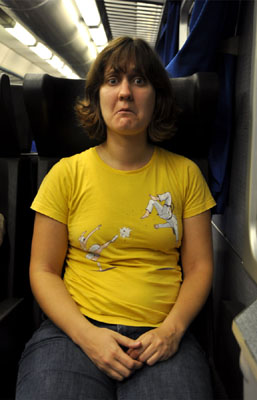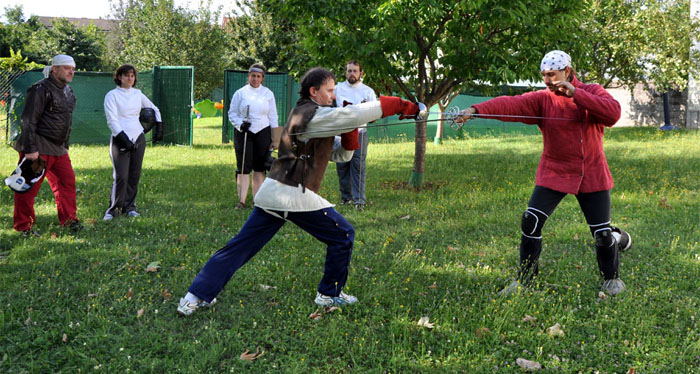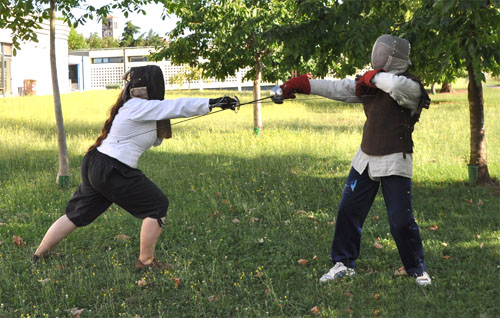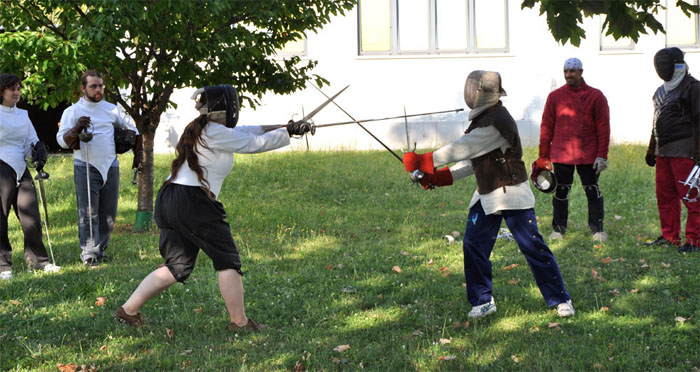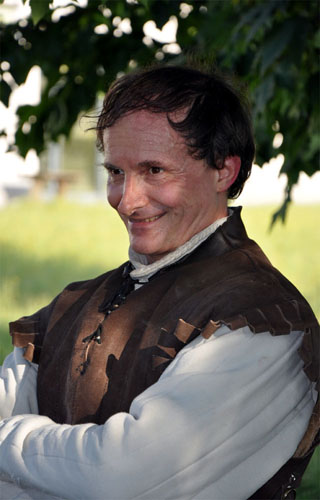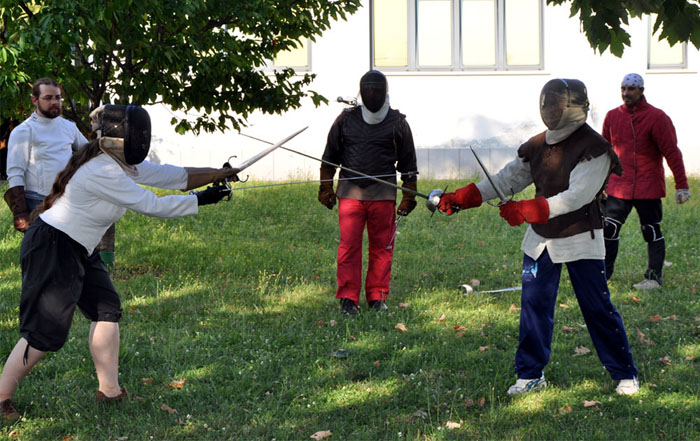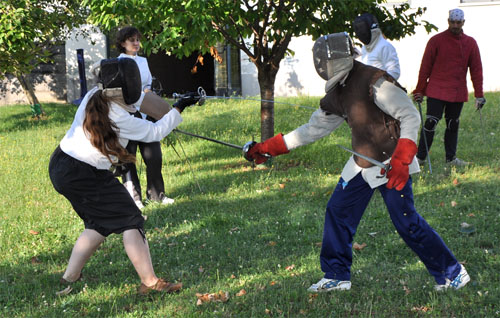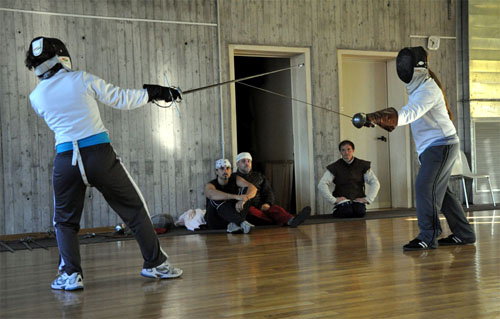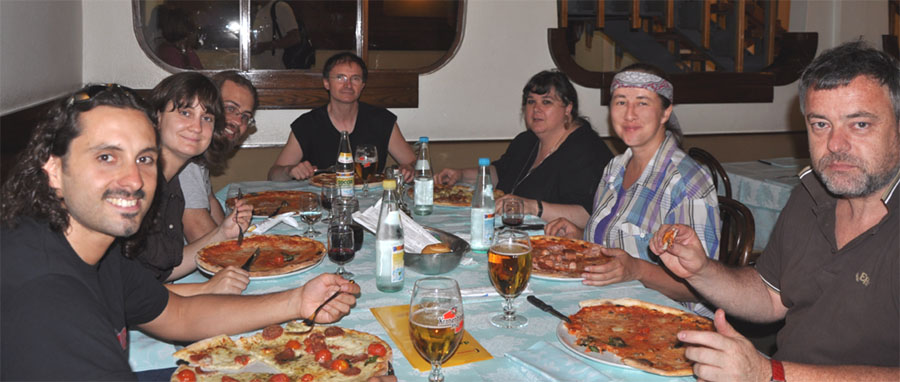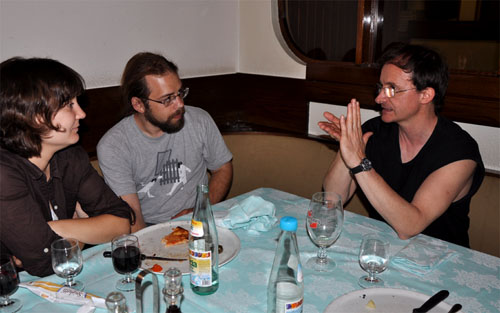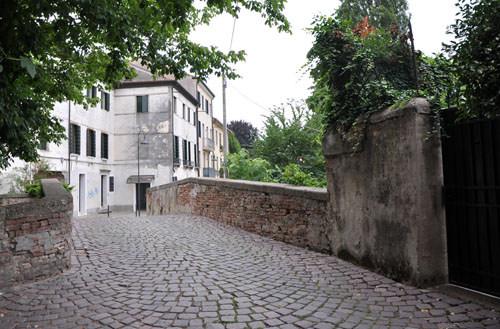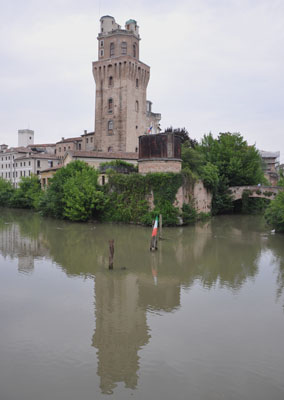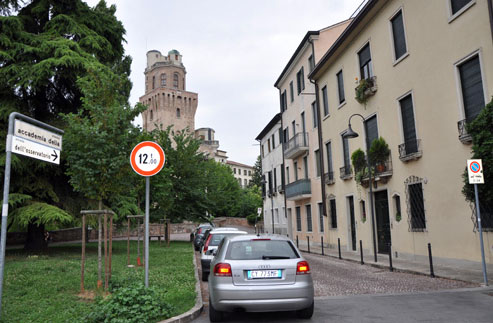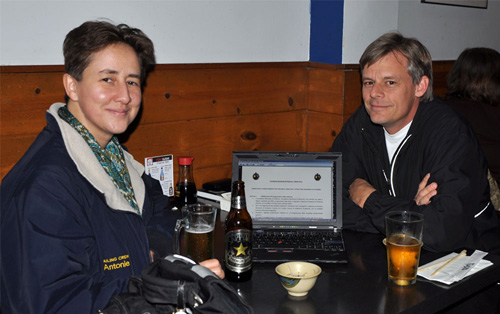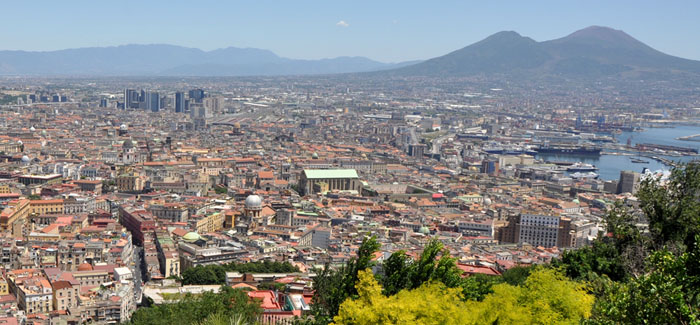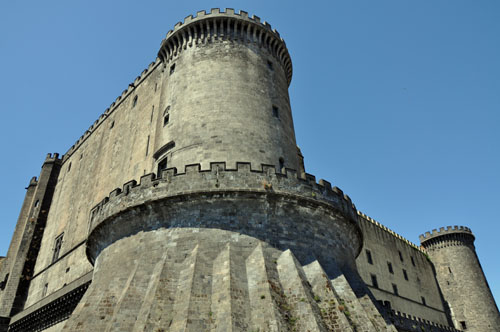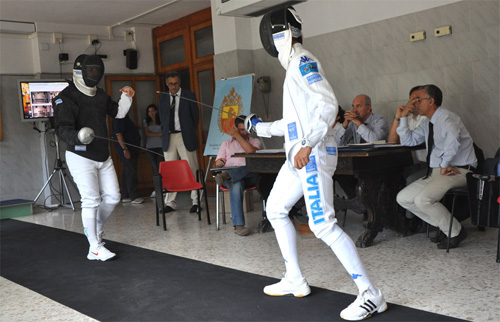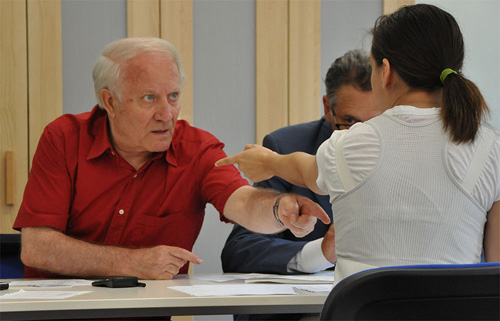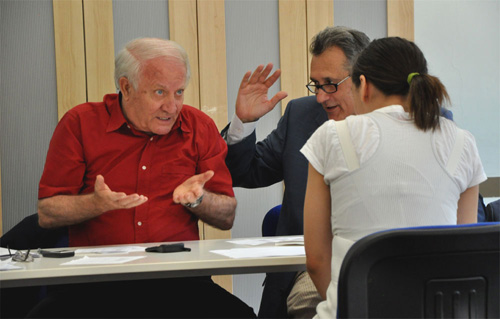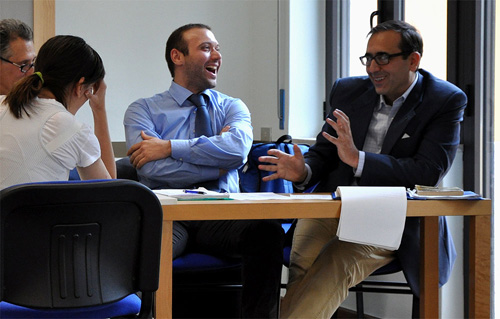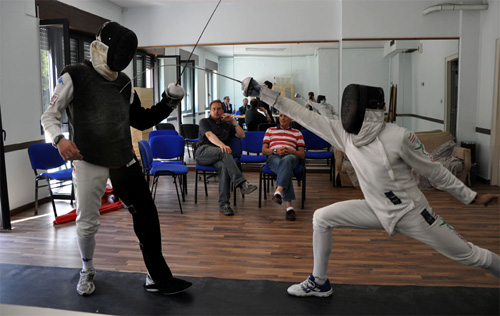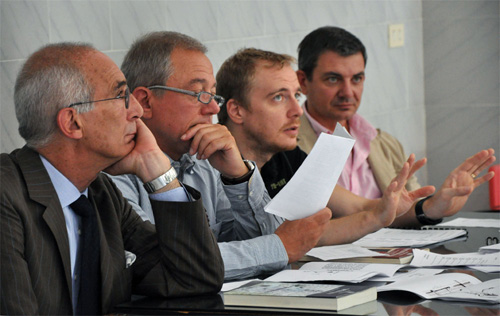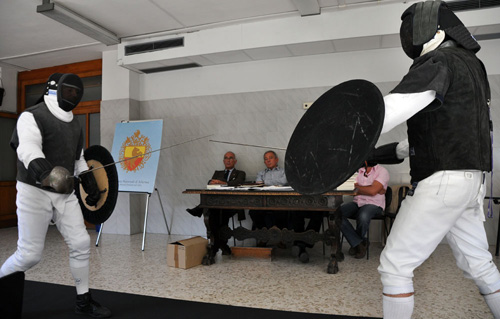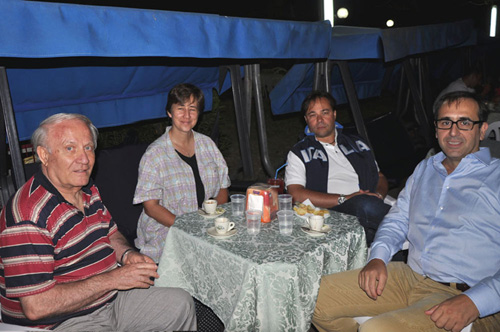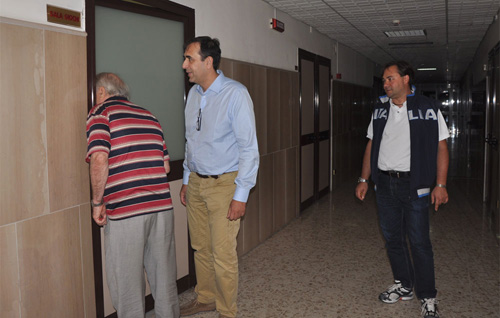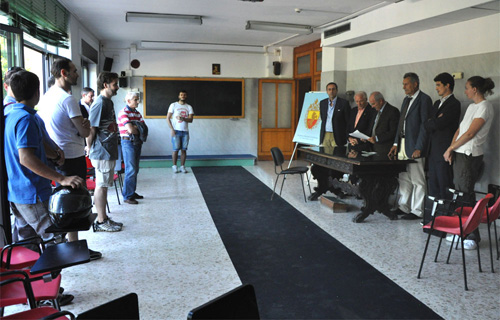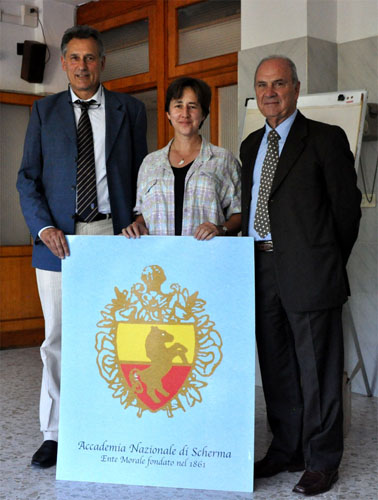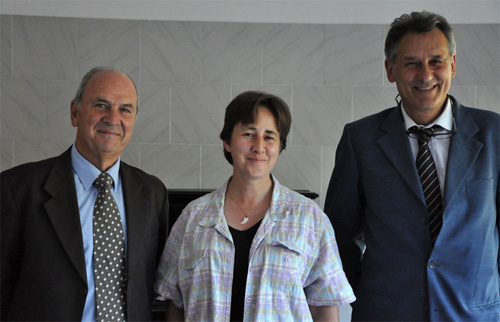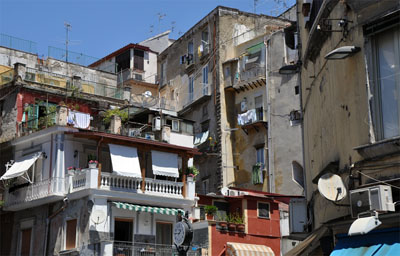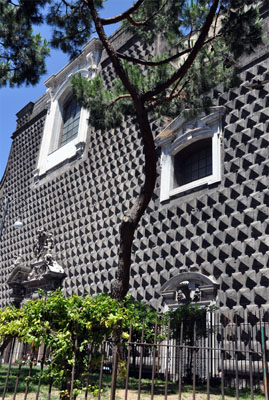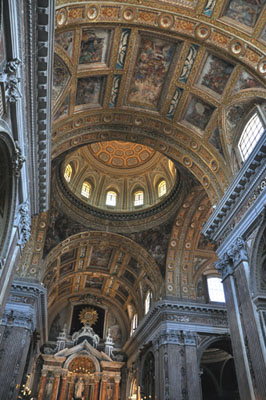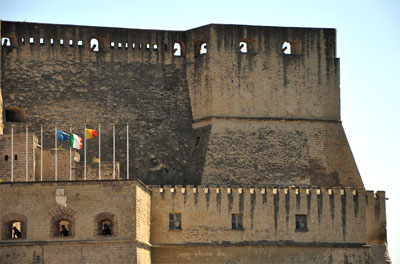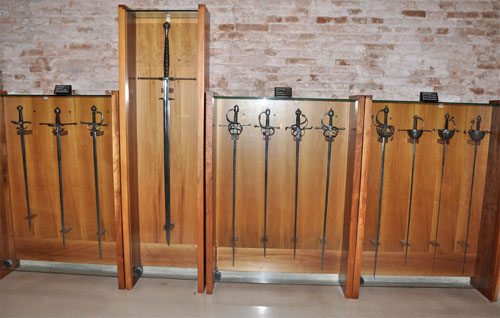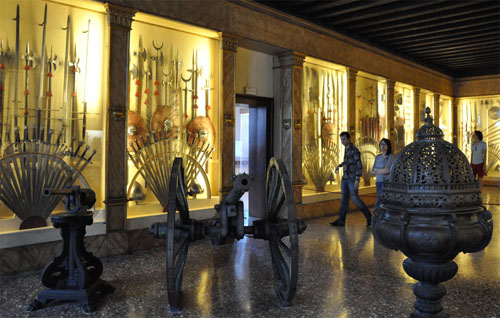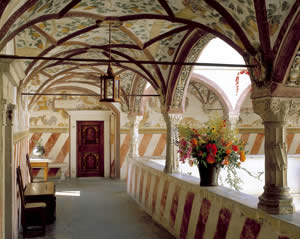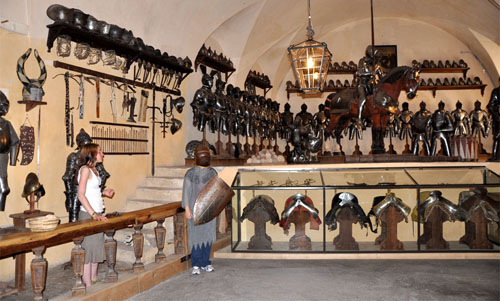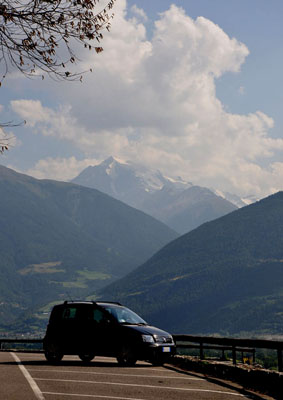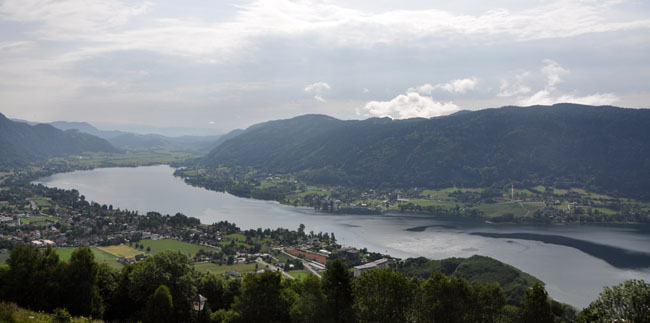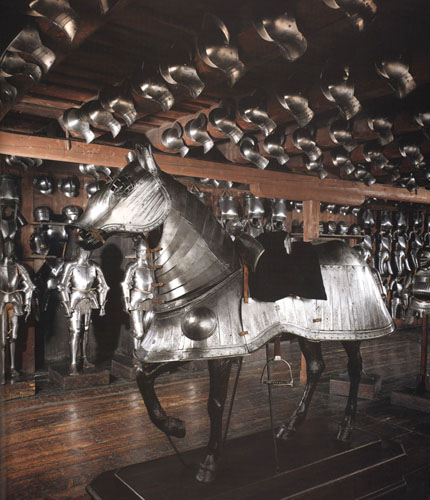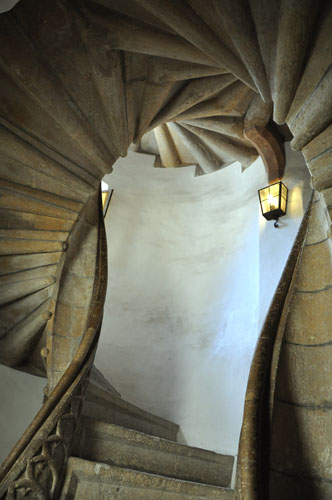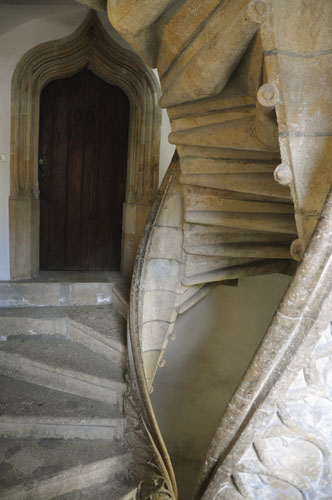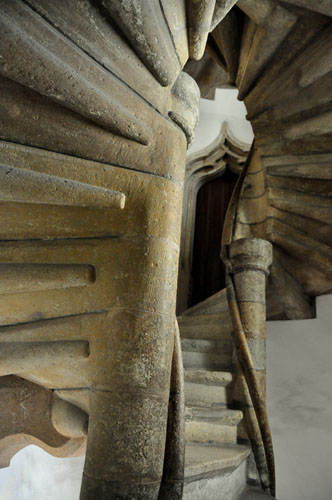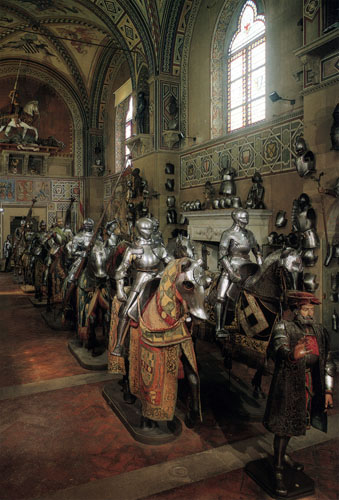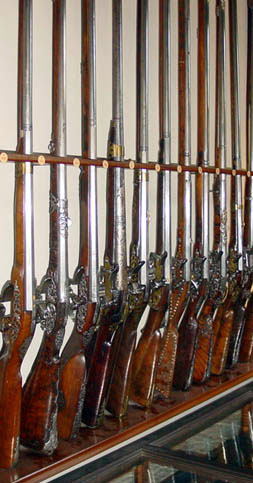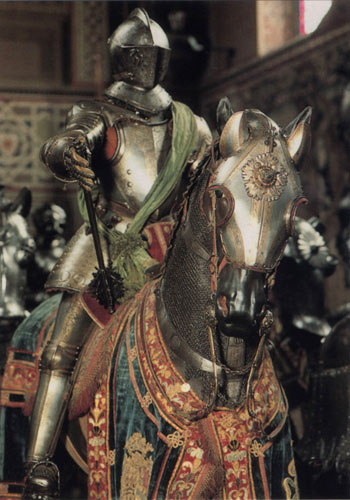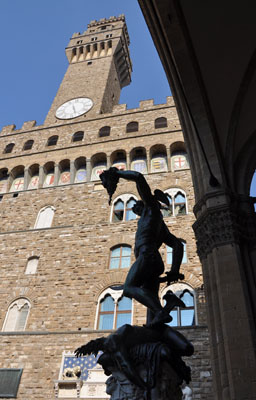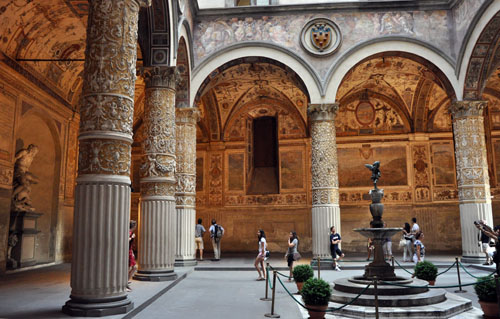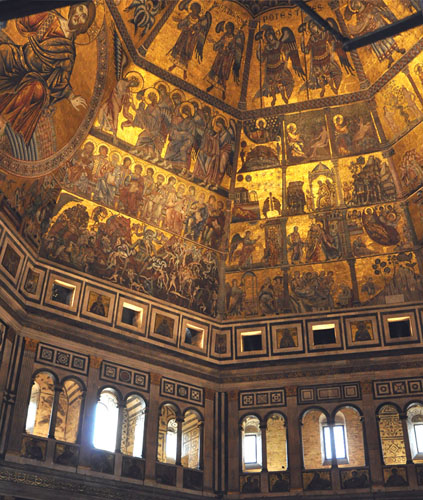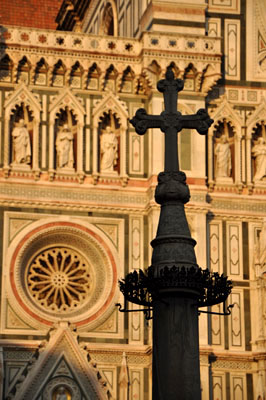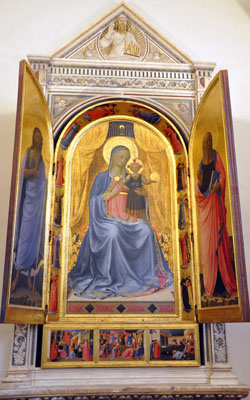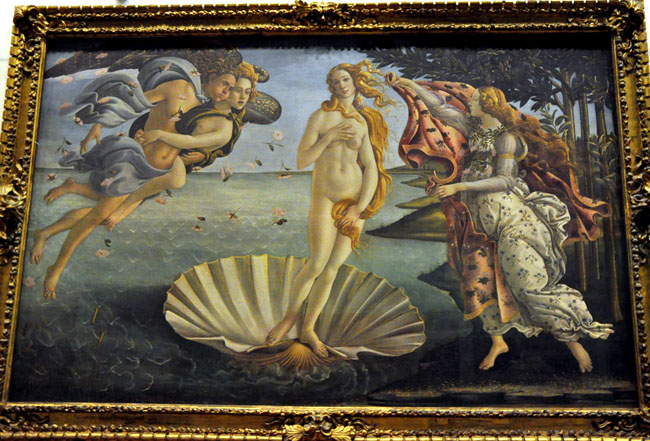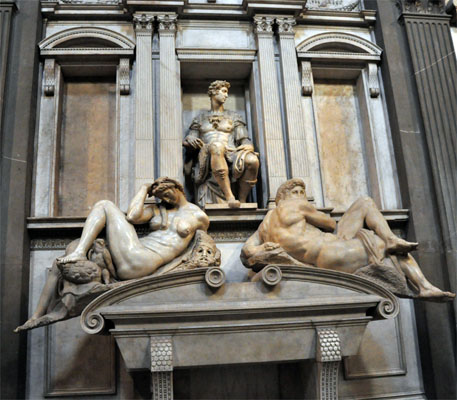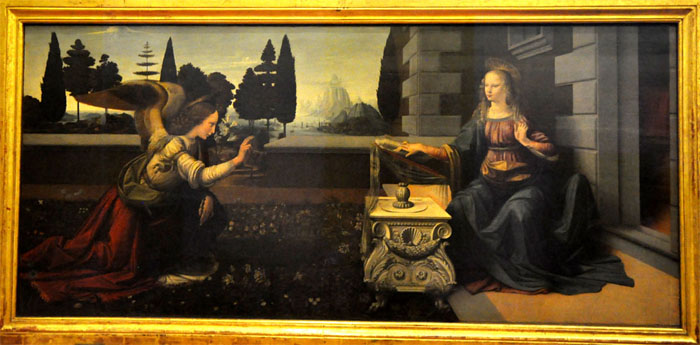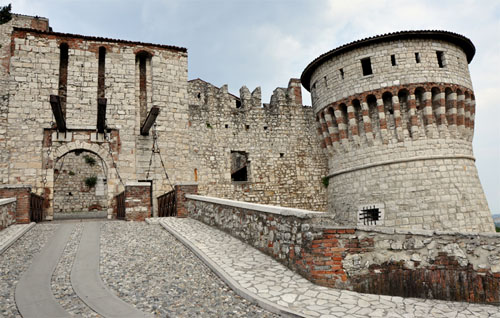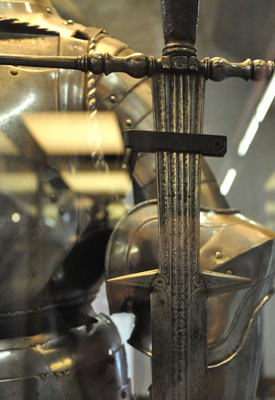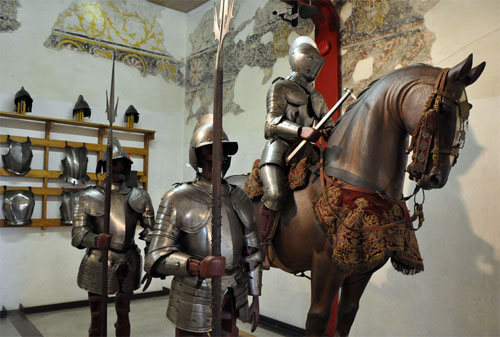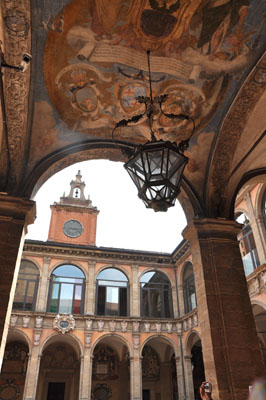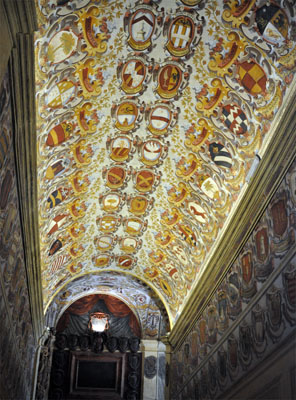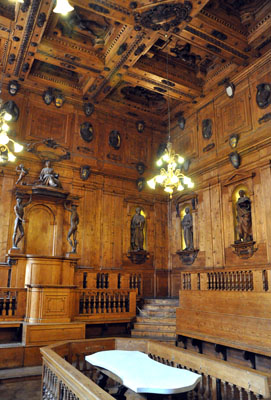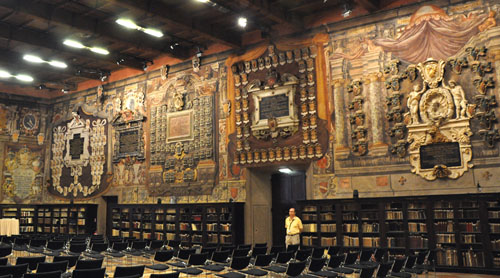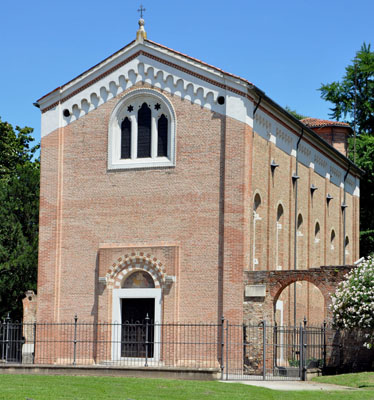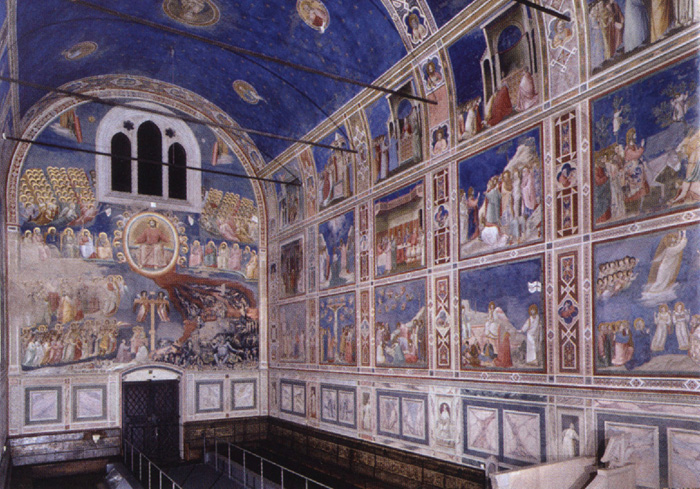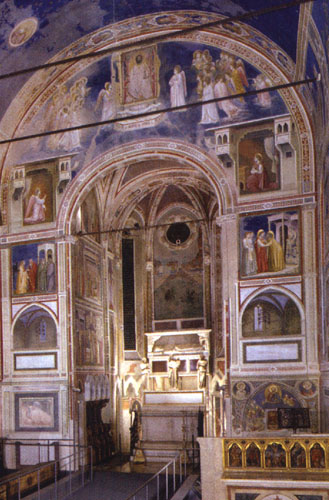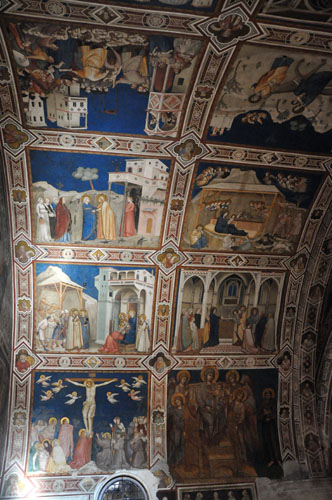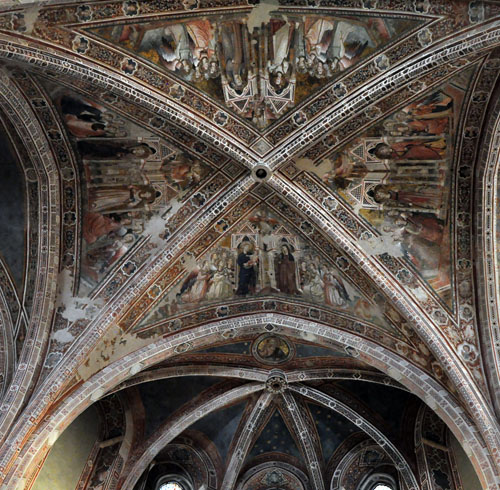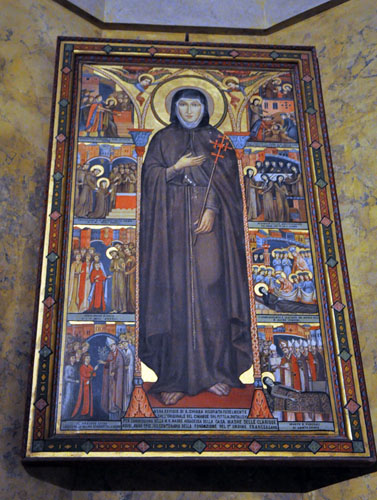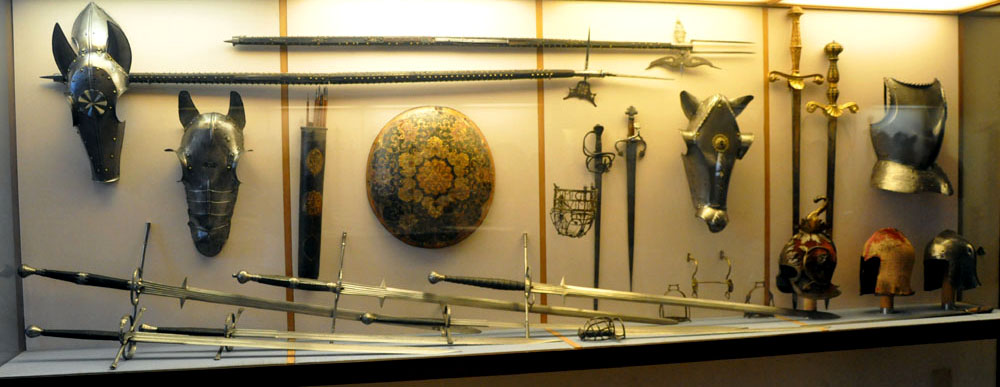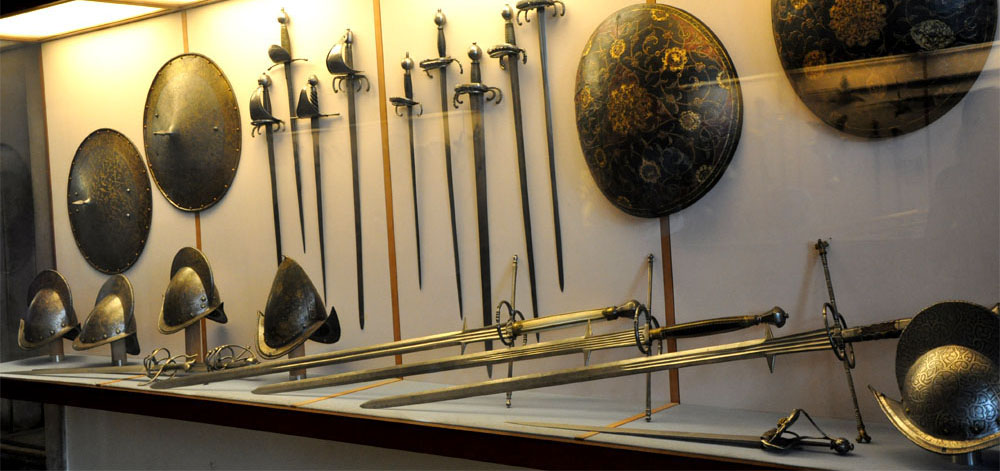|
MAESTRO CARMINE/NINO GALANTE In Verona, the Castelvecchio seems to have become my standard hang-out spot. More exactly, this spot is inside of the castle, at the private club for military officers, of which Maestro Carmine Galante is a member because he used to be a Captain teaching fencing in the army.
Below, in addition to Maestro Galante and his wife (between whom I am seated), please, note the Italian and American flags decorating the table. This dinner (complemented by live music) was put up by the Italian-American Friendship Society.
When Maestro Galante told me he was going to have a back surgery in less than a week after my visit with him, I thought that meant he would not be able to give me lessons. But it turned out that "some pesky surgery" did not stop him from "beating up on me" with "anything he could get his hands on" (that is sabre, epee, and foil :-). And sometimes even with two weapons at once! And the best part was that all our conversations, including the lessons, were happening in Italian (unless it proved more constructive for Maestro Galante to look up a word in his Italian-English dictionary, or for me to look something up in the English-Italian section, which Maestro Galante also provided :-).
I also watched several the Maestro's students prepare for a tournament. And, of course, a visit to the best local pizzeria was mandatory.
Maestro Galante and his wife were very generous and hospitable. In addition to feeding me and having me at their house, Maestro Galante even arranged for the repairs of the little white car, which my brother lent me for my trip, when the car was damaged during a robbery.
A year earlier, two of my Fencing Masters Program classmates, David (now Maestro) and Dori (FMP Instructor), both Coblentz, were involved as well. During our first meeting for coffee and conversation at the Castel Vecchio private officers club, the first thing Maeestro Galante did--that is when he caught me trying to form the Italian formal plural pronoun to refer to him formally and politely (which I might have even managed to accomplish grammatically correctly)--is that he asked me to refer to him in the alternative informal singular form, which, at least in the Czech Republic, only friends and relatives use.
Maestro Galante was not only very generous in sharing with us his experiences concerning fencing in Italy as well as abroad, he was also sincerely interested in learning about life in America, where his only son received his law degree. Maestro Galante also invited us back to the officers club for a concert and again for a dinner on another day, when his wife was able to attend as well.
Maestro Galante's surname is completely fitting, as he was an extremely thoughtful, considerate, and, well...*gallant* host. But in one aspect we ultimately accommodated him. While he was initially doing his best concerning speaking English, during our second meeting we were already speaking only Italian. So it appears that my plan concerning beginning learning Italian already during this my first Italian stay worked out as well. I mean, when I really had to, I was carrying out conversations in Italian, and that after only some three weeks of learning. Together with Dori, we attended classes at the Idea Verona language school during this my first visit. Below, please, see our little class. It does not include Dori because she was in an advanced section, while I was in the total beginners class. At the time of my enrollment in the school, it was obvious that I knew no Italian whatsoever (well, except for some fencing terminology :-). So at least outside of the classroom, during my first week they let me solve organizational issues in English. But already during the second week, they begun pretending they had no clue what I was talking about unless I tried to speak Italian...
A good thing about the Idea Verona school was that they found me accommodation for the moth of my studies. I stayed with the ideal landlady, Irene (pictured right below), who even let me borrow her bicycle for my trips to school as well as around the city. Her house provided the real Italian experience, completed with a balcony covered with flowers, where Irene threw parties for her friends. And the Soccer World Cup, which was taking place in Italy during my stay? (Well, it is really football championship, as the American version of football should really be called "carry-ball," or "hand-ball.") In any case, I would have missed the World Cup altogether had not Maestro Myers sent out an announcement that his historical swordsmanship practice in Sacramento, CA (USA), is cancelled to the end of watching the finals of the World Cup. So I watched at least the very last half an hour of the finals at Irene's house (while the rest of Verona, including David and Dori, partied in front of screens set up in bars all over the city).
Our school also got us discounted tickets to the opera festival, which is one of the largest Verona attractions. It takes place in an arena that has been around since the times of the Roman Empire. A must see of this festival is the traditional Aida (see below). And speaking of my bicycle trips around the town, grocery shopping and such, I must have looked so much like "a local" that people kept approaching me to ask for directions...
Speaking of Verona shopping, the oldest and best known fencing equipment company in Italy--L. Negrini & F.--has been located there since 1897. This means that I had it "in my backyard." So I made sure to take advantage of the Negrini "backyard company" as well. And I am not kidding when I talk about backyard here. The store is located in an unsuspicious house on a quiet street within the historical part of Verona. And the company itself is, well, in this house's backyard. Although once one enters their hallway, it becomes apparent that this is not any regular house...
Should anyone be looking for it, the address is Vicolo Scala Santa, 24. No, they have not paid me for advertising, but I am ready to go back any time. Their sales representatives are well trained for dealing even with customers who "do not really know what they want" (yes, I have tested this their skill thoroughly :-), mistr Negrini gets personally involved when needed as well, more than a few people who saw my new Negrini epee could not tell it in fact has a false (as opposed to true) ricasso, their shoes fit perfectly from the very beginning (it even says "fencing" on them, in addition to Negrini, so Maestro Sahm had to stop making fun of me fencing in "dancing shoes"), and their well-fitting glove is very supple while also washable. The only serious problem I presented was that I wanted to purchase some books as well. Mistr Negrini was the only one able to find them all, and it turned out the desire to read is a sign of a true abroad fencer (as opposed to one living in Italy :-). But Dori presented the Negrini staff with a challenge as well. Since wrist straps constitute a standard part of our equipment (in the Fencing Masters Program), Dori asked for one in a "matter-of-fact" manner. While the sales representative was in fact able to produce one herself, she then had to go and inquire with mistr Negrini about the price of the strap. It turned out that they have not sold one of these for many years, and Dori is now using the last ever wrist strap the Negrini had for sale...
|
